Christopher Columbus
Discovering America
From very early times there existed overland routes of trade between Europe and
Asia. During the Middle Ages traffic over these routes greatly increased, so
that by the fifteenth century a large and profitable trade was carried on
between the West and the East. Merchants in Western Europe grew rich through
trade in the silks, spices, and precious stones that were brought by caravan
and ship from India, China, and Japan. But in 1453 the Turks conquered
Constantinople, and by frequent attacks upon Christian vessels in the
Mediterranean made the old routes unsafe. A more practicable one became
necessary.
Already in the early part of the fifteenth century Portuguese sea-captains had skirted the western coast of Africa, and by the close of the century others of their number had rounded the Cape of Good Hope, in their search for a water route to the Indies. But Spain, at that time the most powerful nation of Europe, adopted a plan quite different from that of the Portuguese. What this plan was and how it was carried out, we can best understand by an acquaintance with the life and work of the great sea-captain and navigator, Christopher Columbus.
More than five hundred years ago there lived in the city of Genoa a poor workingman, who made his living by preparing wool for the spinners. Of his four sons, the eldest was Christopher, born in 1436. Young Christopher was not, so far as we know, very different from most other boys in Genoa. He doubtless joined in their everyday sports, going with them to see the many vessels that sailed in and out of that famous seaport, and listening for hours to the stories of sailors about distant lands.
But he did not spend all his time in playing and visiting the wharves, for we know that he learned his father's trade, and in school studied, among other things, reading, arithmetic, grammar, geography, and map-drawing. We can easily believe that he liked geography best of all, since it would carry his imagination far out over the sea and to lands beyond the sea. In map-drawing he acquired such skill that when he became a man he could earn his living, when occasion demanded, by making maps and charts.
Beyond these facts little is known about the boyhood and youth of Columbus. Very likely much of his early life was spent upon the sea, sailing on the Mediterranean and along the west coast of Africa. Once he went as far north as England and perhaps even farther, but of this we are not certain.
In the course of many voyages he heard much of the work done by Portuguese sailors and discoverers, for Portugal was at that time one of the greatest sea-powers of the world. As Lisbon, the capital of Portugal, was naturally a center for sea-faring men, and as it was also the home of his brother Bartholomew, Columbus, at the age of about thirty-five, went there to live.
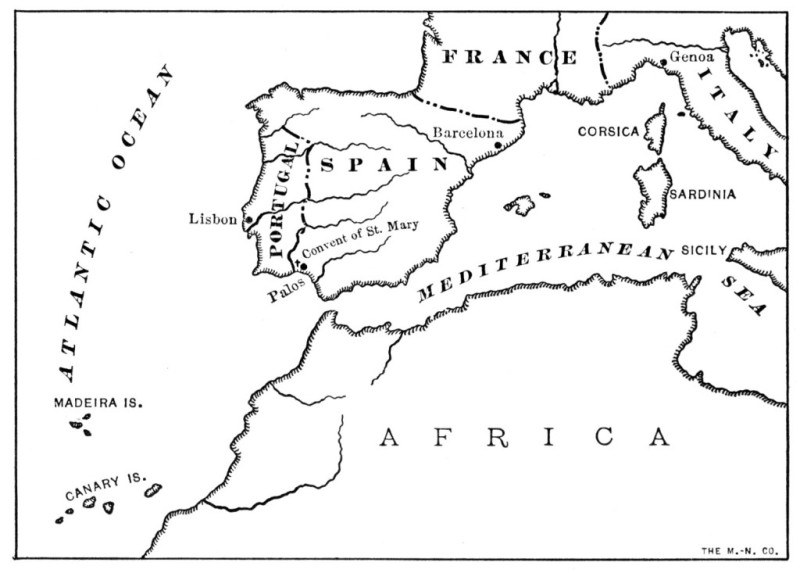
Columbus was a man of commanding presence. He was large, tall, and dignified in bearing, with a ruddy complexion and piercing blue-gray eyes. By the time he was thirty his hair had become white, and fell in wavy locks about his shoulders. Although his life of hardship and poverty compelled him to be plain and simple in food and dress, he always had the air of a gentleman, and his manners were pleasing and courteous. But he had a strong will, which overcame difficulties that would have overwhelmed most men.
While at Lisbon, Columbus married a woman far above him in social position, and went with her to live on a little island of the Madeiras, where her family had business interests. Meanwhile he was turning over in his mind schemes for a future voyage to the countries of the Far East. His native city, Genoa, had grown rich in trading in the silks, spices, and precious stones of the Indies, but the journey overland was dangerous, and a water route was much desired.
This need the Portuguese had felt along with the rest of Europe, and for a long time Portuguese sea-captains had been slowly but surely finding their way down the west coast of Africa, in search of a passage around the southern cape. This route would be easier and cheaper than the old one through the Mediterranean and across Asia. But Columbus thought out a more daring course, by which he planned to sail directly west from the Canary Islands, across the Atlantic Ocean, expecting at the end of his voyage to find the far-famed Indies.
Columbus was so full of his plan that it became the great thought of his life. A water route which would safely bring the wealth of the East to the doors of Europe would be the greatest discovery of the age. Moreover, his ambition was spurred by the thrilling account of a noted traveler, Marco Polo, who two centuries before had brought back from far-off China wonderful tales of golden palaces, of marvelous rivers crossed by marble bridges, and of countless treasures of gold, silver, and jewels.
About 1484 Columbus laid his scheme before King John of Portugal. The king would not promise his assistance, but he borrowed hints from the charts of Columbus, and sent men of his own to learn whether they could reach land by sailing west. Meeting with stormy weather, and fearing the unknown expanse of ocean, the sailors soon put back to port, and brought word that there was no land to be seen.
When Columbus heard what the king had done he was very indignant, and at once quitted Portugal for Spain. The future appeared gloomy enough to the poor navigator without a helping friend. With bitter memories he shook off the dust of Lisbon, and, leading by the hand his little son Diego, five years old, trudged wearily on his journey. Columbus took Diego to the home of the boy's aunt, who lived not far from Palos, and, leaving him in her care, went in search of the king and queen of Spain, Ferdinand and Isabella.
The king and queen were at that time so much occupied in driving the Moors out of Spain that Columbus found difficulty in securing a hearing. When at last he was permitted to unfold his plans to a council of learned men they ridiculed him, because, forsooth, he said that the world was round like a globe, and people lived on the opposite side of the earth. "Such a thing," they declared, "is absurd, for if people live on the other side of the earth their heads must be down. Then, too, if it rains there the rain falls upward; and trees, if they grow there, must grow upside down."
Some of the learned men, however, agreed with Columbus, and thought the carrying out of his plan by the aid of King Ferdinand and Queen Isabella would bring honor and countless wealth to Spain. But their authority was not sufficient to affect those who believed Columbus to be a crazy dreamer or a worthless adventurer.
Month after month, year after year, Columbus cherished his ambitious scheme, encouraged by the few friends who were ready to use their influence for him. He followed the king and queen from place to place, as they moved their camp in the course of the war, and he sometimes fought bravely in the Spanish army. But in face of scorn and ridicule he never gave up hope of success. These were days of great trial, when even the boys in the streets tapped their foreheads as he passed by, and pointed their fingers at him with a peculiar smile.
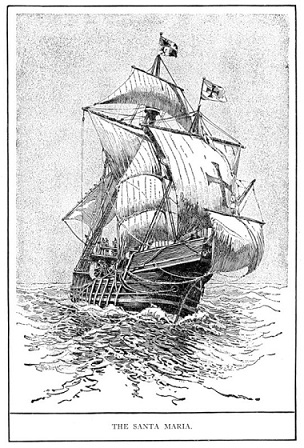
In the autumn of 1491 Columbus made up his mind to leave Spain and try his fortune in France. So he went to the home of Diego's aunt, and once more taking his boy with him, started on foot out of the country which had so little befriended him. We can easily picture him, pale and wayworn, his clothes threadbare, his long white hair streaming over his shoulders. The travelers had gone but a short distance when they stopped at the gate of the Convent of St. Mary, which was only a mile and a half from Palos, to beg bread and water for the boy. At this moment the good prior of the convent happened to pass by. He was a man of learning and, on conversing with Columbus, became much interested in his story, and arranged a meeting of other learned men, among them the well-known sea-captain, Martin Alonzo Pinzon, who lived in Palos. The plans of Columbus appealed so strongly to this sea-captain that he promised not only to furnish money for an expedition, but to accompany it himself.
Moreover, the prior, who had been father-confessor to Isabella, won her over to the sailor's cause. The queen sent what would now be nearly $1,200 to Columbus, and summoned him back to Court. Supplying himself with a mule and suitable clothing, Columbus, with lightened heart, sought the queen's presence. She approved his plan, but Columbus demanded so great a reward for his services as leader of the expedition that the queen refused to come to any agreement with him, and let him go.
Columbus in disgust mounted his mule, and started once more for France. At this juncture, however, one of the queen's advisers hurried into her presence, and put the case so earnestly that she sent a swift courier, who overtook Columbus in a mountain pass not far away, and brought him back. An agreement was soon reached, and Columbus accepted his commission with tears of joy.
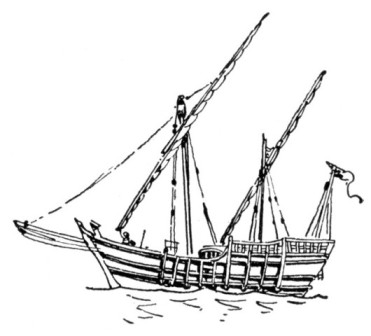
The Nina
He at once went to Palos to get men and vessels for the expedition. But here he met with serious difficulties. Sailors called the Atlantic Ocean the Sea of Darkness, and believed that it contained frightful sea-monsters, ready to dash in pieces all vessels that might come within reach. Moreover, we must remember that the vessels in those days were not safe against storms like the great ships of our day. To venture out upon this trackless sea signified to sailors almost certain death. Hence, they were unwilling to sail, and a royal decree had to be issued to compel them. Even then it became necessary to release criminals from prisons to supply the number required for the expedition.
The three caravels that were at length got ready for the perilous expedition westward in search of the Indies were not larger than many of the fishing-boats of today. The largest of the three—the flagship of Columbus—was called the Santa Maria. The other two were the Pinta and the Niña ("Baby"). The Santa Maria alone had a deck covering the entire hold of the vessel.
At last all was ready, and a half-hour before sunrise on Friday morning, August 3, 1492, this little fleet, with one hundred and twenty men and provisions for a year, sailed out of the port of Palos. It was a sorrowful hour for the poor sailors, who felt that they had looked upon their homes and their friends for the last time. Columbus steered for the Canaries, where he delayed three weeks to repair the rudder of the Pinta.
On September 6th he set sail again. When once out of sight of land the sailors, overcome with fear, cried and sobbed like children. But new trials awaited them. At the end of a week the compass needle no longer pointed to the North Star, and this strange fact filled the superstitious sailors with alarm.
Great was their consternation when a few days later the vessels entered vast stretches of sea-weed. At first the little fleet easily plowed its way through this mass of floating green, but at the end of three days, on account of a light wind, the vessels moved more slowly. In their dismay the sailors feared that the vessels might never get through this immense sea of grass, but might have to lie there and rot, or, perhaps, escaping this danger, run upon rocks and shoals lying just beneath the grass and be broken in pieces. Though they were in the midst of obstacles apparently insurmountable, they were also in the path of the trade winds that steadily bore them onward. But in their terror, the sailors imagined they could never return because the wind would not allow them to sail in the opposite direction. When the wind began to blow from the southwest they were once more relieved of their fears.
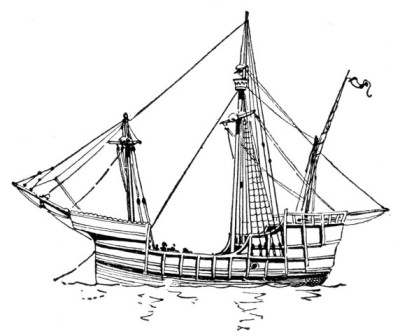
The Pinta
After many days all hearts were gladdened by the sight of birds, which indicated that land was near. It was an idle hope. Again and again some eager-eyed sailor shouted "land," but found later that he was looking at distant clouds.
The crews were in despair. Now in the belt of trade-winds that were steadily blowing them farther and farther from home and friends they cried in dismay: "We can never return to Spain. We are lost! What shall we do?" They begged Columbus to turn back. They became angry when he refused, and declared he was crazy and was leading them all to destruction. They even plotted to throw him overboard some night and say that he fell into the sea while looking at the stars. Columbus felt that dangers were growing thick about him, but he never faltered in his purpose. His strong will and his abiding faith in success kept him stanch in face of difficulties that would have caused an ordinary mind to give way.
On October 11th unmistakable signs of land appeared. A thorn branch with berries on it, a reed, and a carved stick came floating by. New life stirred in every heart, and the sailors looked eagerly in every direction for land.
The king and queen had promised a reward equal to nearly $600 of our present money to the sailor who should be the first to see land. Columbus had promised in addition a velvet cloak. Accordingly, all were on the alert to catch the first glimpse of land, and kept on the watch during the entire night after the appearance of the thorn-branch and carved stick.
About ten o'clock Columbus himself saw in the distance a light, which looked like a torch in the hands of someone moving along the shore. About two o'clock next morning, Friday, October 12th a sailor on the Pinta saw, about five miles off, a low strip of land. This was an island of the Bahama Group. Just ten weeks had elapsed since the voyage began at Palos, and with intense eagerness Columbus and his men awaited the coming of daylight.
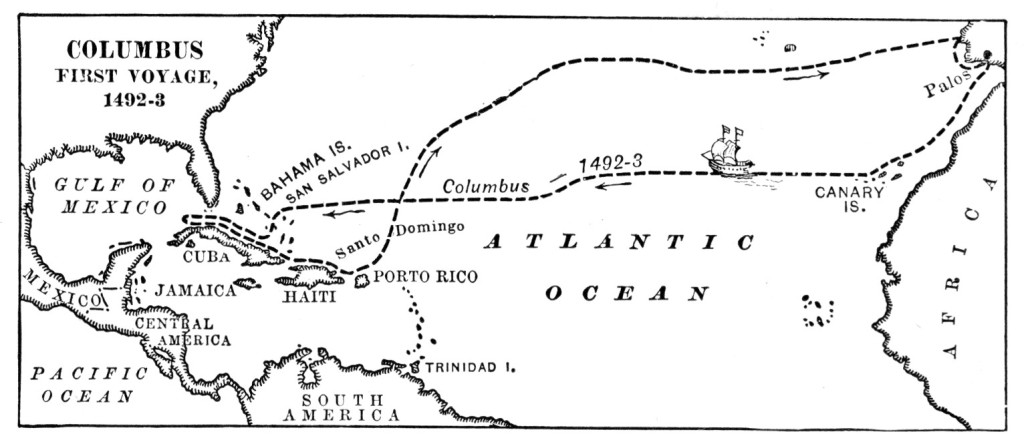
At dawn the boats were lowered, and all went on shore. Columbus, dressed in a rich robe of scarlet, carried the royal standard. His followers also bore banners, on each of which was a brilliant green cross with the letters F. and Y.—the Spanish initials for Ferdinand and Isabella—on each side. Above the letters were crosses. Columbus threw himself, kneeling, upon the ground. He wept for joy, and, kissing the earth, took possession of the land in the name of the king and queen of Spain. The sailors now fell upon their knees at Columbus's feet. They kissed his hands, and begged him to forgive them for their evil thoughts toward him.
At first the natives, whom Columbus called Indians because he thought he was in the East Indies, fled to the woods in fear of the Spaniards; but later they returned and worshipped the white men as beings from the sky. They thought the vessels were great birds and the sails wings. The Spaniards at once began to trade with the Indians, giving them such trifles as tiny bells, red caps, and glass beads, in exchange for tame parrots, cotton yarn, and a few small ornaments of gold, such as the natives wore in their noses.
According to the interesting description of the natives that Columbus wrote in his journal, they were very poor, dark-skinned, and naked. All of them seemed to be young and of strong build, with coarse black hair hanging long behind, but cut short over their foreheads. Their bodies were painted with various colors and in all manner of ways. The men carried sticks, pointed with fish-bones, for javelins, and moved their canoes with paddles that looked like wooden shovels.
The canoes, made out of single trunks of trees, were in some cases large enough to carry forty men. The dwellings, which were clustered together in groups of twelve to fifteen, were shaped like tents and had high chimneys. Inside the tents, hanging between posts, were nets used as beds and called "hammocks."
Columbus called the island upon which he had landed San Salvador (Holy Saviour). He wrote of the new country: "I know not where first to go, nor are my eyes ever weary of gazing at the beautiful verdure. The singing of the birds is such that it seems as if one would never desire to depart hence. There are flocks of parrots that obscure the sun, and other birds of many kinds, large and small, entirely different from ours; trees, also, of a thousand species, each having its particular fruit, and all of marvelous flavor."
Columbus sailed along the coast of Cuba and Hayti, landing here and there, and sent parties inland to find out what they could about the land and its people. Everywhere he was on the lookout for the cities of Asia—those wonderful cities of wealth and beauty described in such glowing colors by Marco Polo. He never doubted that he was in the land he had sought,—the East Indies.
On Christmas morning (December 25, 1492), while it was still dark, as he was cruising along the shores of Hayti (or Hispaniola), the Santa Maria went aground on a sand-bar, where the waves soon knocked her to pieces. As the Pinta had already deserted, there now remained but one ship, the Niña. This little vessel was too small to accommodate all the men, and forty of the number, wishing to stay where they were, decided to build a fort out of the timbers of the wrecked vessel and put her guns in the fort for their defense. These men had provisions for a year, and constituted the first Spanish colony in the New World.
On January 4, 1493, the Niña sailed for Spain. All went well with the sailors until February 12th, when a great storm suddenly threatened to break the frail vessel into pieces. Poor Columbus! His heart grew faint within him. Had he and his men endured such peril and hardship to perish unknown in the sea? Would the world never know of their great achievement?
In his anxiety he wrote on parchment two separate accounts of his discovery, which he sealed and addressed to Ferdinand and Isabella. He then wrapped each in a cloth and, enclosing them in large cakes of wax, put them into barrels. One of these barrels he flung into the sea, and the other he kept on deck. The Niña passed safely through the storm, however, and on March 15th, after an absence of nearly seven and a half months, cast anchor in the harbor of Palos.
The successful voyager lost no time in reaching Barcelona, where he was received by the king and queen with triumphal honors. Everybody was ready to praise the man who had become so famous. There was a great procession in his honor in the streets of Barcelona. Leading this street parade were six Indians whom Columbus had brought back with him. These were smeared with paint, decked with feathers of tropical birds, and ornamented with bits of gold. Following them came men carrying stuffed and live birds of brilliant plumage, and the skins of different animals, all products of the New Land. Columbus rode on horseback, attended by many of Spain's great men, mounted on horses.
When the procession reached the house in which King Ferdinand and Queen Isabella were, Columbus went into the room where they sat on the throne. They did him the honor to rise as he entered, and when he knelt to kiss their hands, they again honored him, by bidding him rise and sit, like an equal, in their presence.
The poor sailor, once despised as an idle dreamer, had become a distinguished personage, honored alike by kings and princes and people. It was no longer necessary to force men by royal decree to sail with the great admiral. Many were now eager to go where they might reap wealth and honor.
In September, 1493, Columbus again sailed, this time with a fleet of seventeen vessels and fifteen hundred men. Many of the latter were young men of noble birth, and belonged to families of wide influence. All supposed they were going to the East Indies, the land of jewels and spices and precious metals. With the purpose of founding a colony, Columbus took with him not only horses, mules, and cattle, but vines, vegetables, and seeds of many kinds.
When the fleet reached the island of Hayti, and the place where he had in the previous winter left the little colony of forty men, he found that the fort and provisions had been destroyed, and that eleven corpses had been buried nearby; but not one of the forty men was ever again seen alive. After building a little town, called Isabella in honor of the queen, Columbus began exploring by land and sea. He found much that was beautiful and interesting, but much more that was disappointing. Moreover, the Indians were sometimes unfriendly, and his own men were often unruly and treacherous. At length, after four years of varying fortune, he started home, and after a long, hard voyage, during which provisions gave out, he and his men, weak with hunger, finally reached Spain in June. He was kindly received, and was promised more ships for another voyage.
In May, 1498, with six vessels and two hundred men besides the sailors, Columbus started on a third voyage, this time directing his course more to the south than he had done before. He landed on an island which he named Trinidad, and then sailed along the northern coast of South America.
He was not well, however, and in August turned his course for Santo Domingo, where he found things were going badly. Trouble with the Indians had arisen, and even more serious trouble in the colony itself had broken out. For two years Columbus struggled to set things right. But he was not successful as a colonizer. Besides, many people were beginning to lose faith in him because he did not get expected treasures for Spain. Many others were jealous of his fame, and plotted to ruin him. At length an official was sent from Spain to Hayti to look into the situation. When he reached the island he confiscated Columbus's property, put him in chains, and sent him as a prisoner to the country from which he had but recently sailed with high honor.
In Spain the people were in sympathy with the admiral in his disgrace; so too was the queen, who sent money and summoned him to court. She received him there with tears in her eyes, and he broke down and wept at her feet.
In 1502 Columbus started on a fourth voyage, sailing along the eastern coast of Central America. But he was not able to accomplish much, and finally suffered shipwreck on the island of Jamaica, where he spent a year of misery. At last he set out for home, arriving there only a short time before Queen Isabella, his only protector, died.
Poor, sick, and discouraged, Columbus dragged out a weary life for eighteen months longer. He died in Spain on May 20, 1506, in utter ignorance of the greatness of his discovery. So little appreciated was he that the city annals make no mention of his death. It remained for succeeding generations to lift his name from obscurity and to give faithful acknowledgment of his achievements in the advance of human progress.


